Product Categories
SHOP BY ARTIST
NEWSLETTER
Products
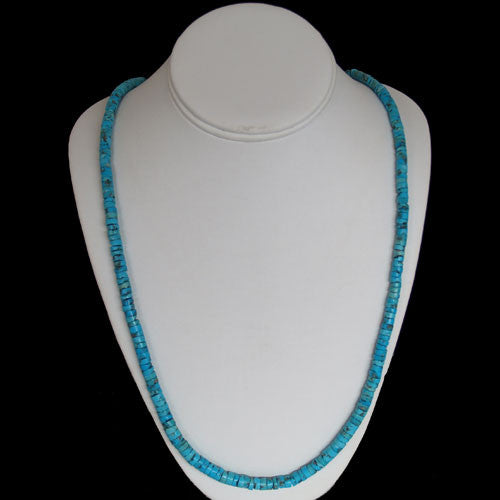
Santo Domingo Handmade Natural Gem Grade Sleeping Beauty Turquoise Bead Necklace - Ray Lovato (#138)
$3,950.00
Artist: Ray Lovato
Length: 37"
Wrap: 5"
Sleeping Beauty Turquoise
The Sleeping Beauty turquoise mine is located seven miles from Globe, Arizona. The mine is one of the largest producers of turquoise in North America. The mine, and the turquoise extracted from it, derives its name from Sleeping Beauty Mountain, which at one time was part of the Copper Cities operation. The center of the copper mine is located at approximately 33o24"13.23"N. 110o53'34. 60"W, at an elevation of 1224 feet. Sleeping Beauty Turquoise Mining is presently owned and operated by Monty Nichols.
For many centuries before the first Europeans made their way into Arizona, turquoise was being mined on the slopes of Sleeping Beauty Mountain. The Salado and other ancient peoples mined the beautiful sky stone from several surface outcroppings located in the vicinity, including Pinto Valley. It is believed that Spanish explorers were the first Europeans to locate the source of Sleeping Beauty sometime around the 1860s. By the 1870s, small underground mines pockmarked the hills surrounding present day Globe.
Cities Service Company started the Copper Cities Mine (commonly called the Sleeping Beauty Mine) in 1952 and operated it until the Pinto Valley mine opened in 1972. During the 1960s, L.W. Hardy had the contract to mine turquoise, both at Sleeping Beauty and at Castle Dome, later called the Pinto Valley Mine. Formerly a meat cutter at a market in Miami, Hardy recognized early on that turquoise was more valuable as a gemstone than the associated copper.
By the time the turquoise boom began, Hardy had contracts with mining companies in Miami, Kingman and elsewhere. He also developed a method for stabilizing low-grade, porous turquoise with pressure-impregnated hot acrylic resin, which hardened the stone and improved the color.
Hardy's mining methods were primitive when compared with current operations. Hardy's workers sat in a ditch ripped by a bulldozer and hand picked the stone from waste-rock. Hardy mined turquoise at Sleeping Beauty for 22 years, getting about 45 percent recovery, and leaving the rest in waste dumps.
Monty Nichols received the contract to mine Sleeping Beauty turquoise in 1988, and began using modern mining methods to develop the property. Nichols drills and blasts the overburden, hauling it to the abandoned Copper Cities pit, which now contains the recycled tailings from Miami Copper Company's No. 5 tailing dam. The old dam dominated the eastern skyline of downtown Miami until recently. The year Nichols acquired the contract; he began a two-year project to remove 5,000.000 tons of overburden. Located half way up the side of an open pit mine, the narrow turquoise-bearing zone has about 400 feet of hard waste rock on top of it. In order to move sideways into the ore-body, a whole slice of the mountain had to be removed.
To avoid fracturing the turquoise, Nichols was careful not to blast too near the turquoise-bearing strata. That layer is more crumbly, so the miners can rip it and dump it over screens, separating the material by size. No crushers are used, again to avoid fracturing the gemstone, and the different sized rock is hauled up to a wide mine bench where conveyor belts move the material through three buildings. There, workers handpick turquoise from the broken rock. The buildings are vented with filtered air to eliminate workers' exposure to dust, and well insulated to keep them comfortable in any weather. It is a far cry from the old methods of mining. Anywhere from 30 to 40 people work at the mine at any one time, depending on how much mining there is to do.
Fifty years ago, mine workers filled lunch buckets with the colorful rock, even though it was reason for immediate termination. Old habits die hard, and some people still think it is okay to sneak in and try to pick turquoise. As a result, security is tight in and around the mine. Motion detectors, night vision cameras and 24/7 roving patrols are used, so the only turquoise leaving the property now is being shipped to markets around the world.
Italy is the largest volume buyer of Sleeping Beauty turquoise, with Germany and Hong Kong following closely behind. These customers buy the best grade for their exclusive jewelry. Jewelry makers in India and Spain also receive Sleeping Beauty turquoise, while in the U.S., Gallup and Albuquerque are the largest consumers.
The Sleeping Beauty turquoise mine produces a uniform light to medium blue turquoise with rare finds of deep, dark blue. Because of its uniformity, it has been a favorite of the Zuni Pueblo. Zuni silversmiths often use it in channel inlay and various types of cluster work that require large numbers of small, perfectly matched stones. The Sleeping Beauty mine has been one of the larger producers of rough turquoise in the United States, although today much less good turquoise is being produced than in the past.
Sleeping Beauty turquoise is noted for its solid, light blue color with no matrix; the host rock is usually granite. Nichols says the mine is producing about 1,600 pounds a month. Of that, only four percent is natural; most of the turquoise from the mine is altered in some way. Most is enhanced, which is more expensive than stabilization, and sold to large distributors in this country and Europe. Currently most of the turquoise that comes from the mine is from the tons of tailings piles that have been accumulating for decades.
The best of the Sleeping Beauty turquoise is comparable to that found in the Middle East. It is thought that large quantities of Sleeping Beauty turquoise is taken overseas and smuggled into, then out of, Iran to be sold as “Persian” turquoise.
About the artist:

The gift of humor is a blessing to those who have it, and to those of us exposed to the comic. From an early age, Steve and I have been blessed with the humor of Santa Domingo artist Ray Lovato. Not only does Ray create exceptional jewelry, he does it with wit and comedy. He always has an aura of happiness around him, and this attitude seems to spread, like a California fog, to those who know him. In addition to his artistic talents, Ray is also a gifted salesman. When he pulls up in front of the trading post we know that there is a good possibility that we will soon be parting company with our available cash.
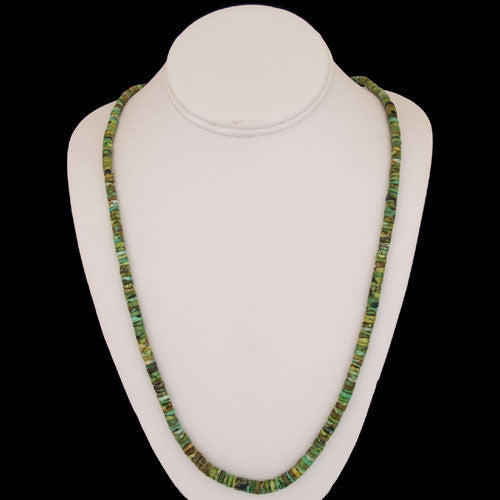
Santo Domingo Handmade Natural Gem Grade Stennich Turquoise Bead Necklace - Ray Lovato (#147)
$6,500.00
Artist: Ray Lovato
31" long
Wrap: 4 3/4"
Stennich Turquoise
August “Gus” Stenich was an elderly Austrian emigrant who owned a gold mine along with several significant turquoise claims, including his namesake, Stenich. Gus quickly developed a reputation as an ornery and suspicious character, figuring this type of reputation would help protect his claims from the many turquoise scavengers and cheats who would steal turquoise and gold from his claims when he was in town buying supplies. The Stenich mine and all of Gus’s claims were willed to J.W. Edgar upon Stenich’s death. It is said that his last will and its details were written out on an old bread wrapper paper that was found with Gus’s body at his Stenich campsite.
About the artist:

The gift of humor is a blessing to those who have it, and to those of us exposed to the comic. From an early age, Steve and I have been blessed with the humor of Santa Domingo artist Ray Lovato. Not only does Ray create exceptional jewelry, he does it with wit and comedy. He always has an aura of happiness around him, and this attitude seems to spread, like a California fog, to those who know him. In addition to his artistic talents, Ray is also a gifted salesman. When he pulls up in front of the trading post we know that there is a good possibility that we will soon be parting company with our available cash.
Related legends:
Precious Stones
Turquoise; Precious stones have symbolic implications. For example, turquoise if a "collective term for all the precious stones, wealth, or mixed offerings. Good fortune is attributed to this stone." Both white shell and turquoise are emphasized in Kinaalda? More about this legend
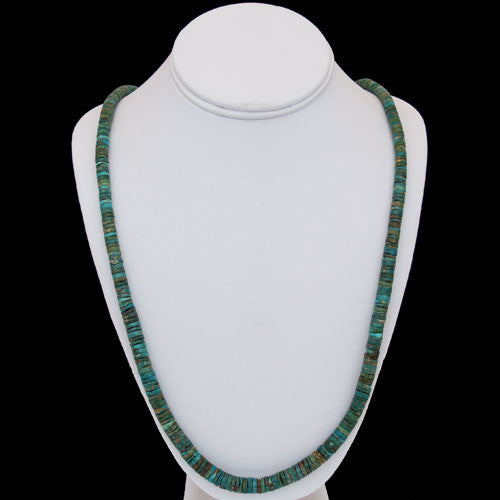
Santo Domingo Handmade Natural Gem Grade Stone Mountain Turquoise Bead Necklace - Ray Lovato (#143)
$8,500.00
Artist: Ray Lovato
Length: 35"
Wrap: 6 1/4"
Stone Mountain turquoise is not extremely well known. Not yet anyway. It is a mine that has not produced large quantities of turquoise. The top end is however, very beautiful. With much straining of the eyes and finger picking through the rough material, we have sorted a selection of high-grade green material. When we showed the selection of stones to Ray Lovato, his desire to work it was off the charts. Ray created this most stunning necklace that will certainly cause connoisseurs of natural turquoise to reconsider their opinions. There is top grade turquoise in every mine, and this is some of the very best from Stone Mountain.
Stone Mountain Turquoise
Stone Mountain Mine is located in high deserts of Lyon County, Nevada. The mine was discovered in the late 1970's. The majority of the turquoise recovered from this mine is recovered by pick and shovel.
About the artist:

The gift of humor is a blessing to those who have it, and to those of us exposed to the comic. From an early age, Steve and I have been blessed with the humor of Santa Domingo artist Ray Lovato. Not only does Ray create exceptional jewelry, he does it with wit and comedy. He always has an aura of happiness around him, and this attitude seems to spread, like a California fog, to those who know him. In addition to his artistic talents, Ray is also a gifted salesman. When he pulls up in front of the trading post we know that there is a good possibility that we will soon be parting company with our available cash.
Related legends:
Precious Stones
Turquoise; Precious stones have symbolic implications. For example, turquoise if a "collective term for all the precious stones, wealth, or mixed offerings. Good fortune is attributed to this stone." Both white shell and turquoise are emphasized in Kinaalda? More about this legend
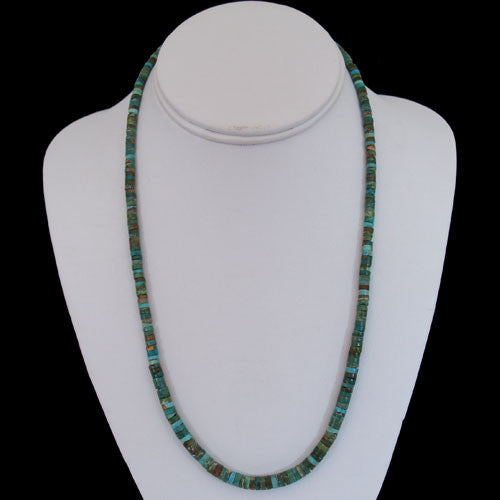
Santo Domingo Handmade Natural Gem Grade Stone Mountain Turquoise Necklace - Ray and Melissa Lovato (#146)
$1,375.00
Artist: Ray and Melissa Lovato
21" long
The turquoise in this necklace is high-grade and natural, which is exactly what Ray Lovato loves to work with. The turquoise is from Nevada Cassidy's, Stone Mountain mine in Nevada. The turquoise from this location is often found in small pieces, what Ray likes to call "corn flake turquoise," because that is what it looks like in the rough. It is perfect for Ray to shape his beads from and the end result is . . . well . . . perfect!
Stone Mountain Turquoise
Stone Mountain Mine is located in high deserts of Lyon County, Nevada. The mine was discovered in the late 1970's. The majority of the turquoise recovered from this mine is recovered by pick and shovel.
About the artist:
The gift of humor is a blessing to those who have it, and to those of us exposed to the comic. From an early age, Steve and I have been blessed with the humor of Santa Domingo artist Ray Lovato. Not only does Ray create exceptional jewelry, he does it with wit and comedy. He always has an aura of happiness around him, and this attitude seems to spread, like a California fog, to those who know him. In addition to his artistic talents, Ray is also a gifted salesman. When he pulls up in front of the trading post we know that there is a good possibility that we will soon be parting company with our available cash.
Related legends:
Precious Stones
Turquoise; Precious stones have symbolic implications. For example, turquoise if a "collective term for all the precious stones, wealth, or mixed offerings. Good fortune is attributed to this stone." Both white shell and turquoise are emphasized in Kinaalda? More about this legend
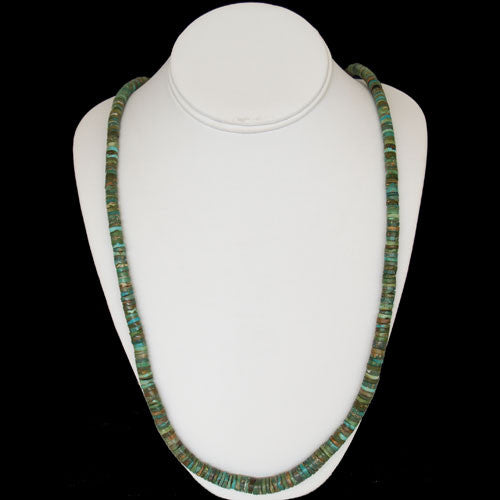
Santo Domingo Handmade Natural Gem Grade Stone Mountain Turquoise Necklace - Ray Lovato (#136)
$6,500.00
Artist: Ray Lovato
Length: 35 1/2"
Wrap: 6"
Handmade turquoise beads, those are Ray Lavato’s specialty. Ray makes them in the old style, and his necklaces are always, and I mean always, beautiful. One of the nicest things about them is that they get prettier the more you wear them. After a time, the turquoise takes on a personality of its own and, like its wearer, becomes distinctive. This natural Stone Mountain turquoise necklace will make you happy for a very long time, and then be ready for the next generation of wearers.
Stone Mountain Turquoise
Stone Mountain Mine is located in high deserts of Lyon County, Nevada. The mine was discovered in the late 1970's. The majority of the turquoise recovered from this mine is recovered by pick and shovel.
About the artist:

The gift of humor is a blessing to those who have it, and to those of us exposed to the comic. From an early age, Steve and I have been blessed with the humor of Santa Domingo artist Ray Lovato. Not only does Ray create exceptional jewelry, he does it with wit and comedy. He always has an aura of happiness around him, and this attitude seems to spread, like a California fog, to those who know him. In addition to his artistic talents, Ray is also a gifted salesman. When he pulls up in front of the trading post we know that there is a good possibility that we will soon be parting company with our available cash.
Related legends:
Precious Stones
Turquoise; Precious stones have symbolic implications. For example, turquoise if a "collective term for all the precious stones, wealth, or mixed offerings. Good fortune is attributed to this stone." Both white shell and turquoise are emphasized in Kinaalda? More about this legend
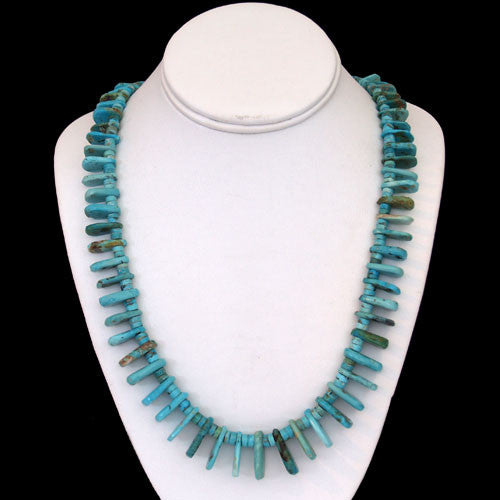
Santo Domingo Handmade Natural Gem Grade White-horse Nevada Turquoise Tab Necklace - Ray Lovato (#144)
$1,250.00
Artist: Ray Lovato
Length: 30"
Largest tab: .43" x .87"
Ray Lovato is to tab turquoise necklaces what Barry and Steve are to Twin Rocks, inseparable. I know that is a shameless comparison, but I can’t help it. We can’t get out of the post and Ray cannot stop making beads. So there we are! This tab necklace features the best of Ray’s work. Made with Whitehorse turquoise from Nevada, it is appropriate for traditional or contemporary celebrations.
Fox Turquoise
Fox turquoise jewelry has been a part of fine Native American turquoise jewelry for decades. The Fox mine has probably produced more turquoise than all the other mines in the state put together; a conservative estimate of the total production has been put "not less than 500,000 pounds." For years the mine produced more than 2,000 pounds of turquoise a month. The bulk of Fox turquoise is only a fair quality, being deficient in color, but is quite hard and excellently suited to artificial coloring. For this purpose, most of the mine production for years was sold to factories in Idar-Oberstein, Germany. Much excellent ore was, however, processed in the United States.
The Fox turquoise mine is in a faulted, argillized block of chert in which the beds strike predominantly N. 60-degrees E. and dip about 45 degrees SE. Pseudomorphs of limonite after pyrite attest to the former presence of pyrite in the argillized zone. Greenish and blue turquoise occur in silicified, limonite veinlets that follow the bedding. Smaller veinlets form flat-lying units in the chert.
George Schmidtlein visited the deposit about 1910 or 1912; the location of the Fox mine was revealed to Schmidtlein by a servant in his household. The Indians had known it for centuries and almost everyone in the vicinity had some of the turquoise in one form or another. In 1912 Schmidtlein and his wife made a trip east, taking some of the turquoise to the C. D. Peacock Jewelry Co., in Chicago. Peacock agreed that Fox turquoise was "very pretty," but knew of no market for it, so Schmidtlein dropped the matter.
In 1914, Charles Schmidtlein, son of George, and Johnnie Francis filed an official notice of location on the property under the name of "Fox Lode Mining Claim." Other mines had been developed in Nevada at the time, and a definite market for the ore had been established. Schmidtlein and Francis worked the claim until they had established its value and, in 1915 sold the property to William R. McGaw for $3000.00.
McGaw put a crew of miners to work extending the development. The Fox turquoise mine has been developed as an open cut. Another cut was opened along the face of the vein and production expanded. Following the death of McGaw, Edward C. Smith, a relative, assumed management of the mine. When Smith died, his son Charles E. Smith became manager.
In the 1940's, Dowell Ward purchased the old Cortez claims and developed them using the names Fox, White Horse, Green Tree and Smith to differentiate among the colors produced in the area and to create a larger perceived share of the turquoise market. The area produces a huge amount of good quality green or blue-green turquoise with a distinctive matrix. The story is told that during the time he owned the claims, Dowell Ward, amassed one of the largest collections of rough turquoise ever. Dowell's widow Faye is now in possession of the collection and the claims.
The turquoise was found in nodules of all sizes; hundreds were as large as a man’s fist, many even larger. The Fox mine is also known for the sea foam type of nuggets and blue green kind of bubbly material it produces. It is often left in its "nugget" rough state and slightly polished for that appearance. The mine is being worked again and this is new material. The color ranges from blue/green to a dark blue. The material is solid and hard (for turquoise) and cuts well. The rough is almost all nuggets.
The largest true-blue nugget without matrix inclusions found at the Fox turquoise mine weighed slightly more than one pound, (a troy weight pound is about 1,866 carats) and was presented to the Smithsonian Institution in Washington, D.C. Another huge nugget, almost as large, was presented to Tiffany & Co., New York City. Mrs. Clara L. McGaw had a nugget, which weighed about one pound but this had a slight amount of matrix in it.
Fox Mine; Nevada, Lander County, Bullion District. The Cortez or Fox turquoise mine is in the bottom of a canyon in the NE1/4, sec. 34, T. 27N, R. 47 E. about 1.5 miles southwest from the mouth of Cortez Canyon. The mine is accessible over a well-graded road.
About the artist:
The gift of humor is a blessing to those who have it, and to those of us exposed to the comic. From an early age, Steve and I have been blessed with the humor of Santa Domingo artist Ray Lovato. Not only does Ray create exceptional jewelry, he does it with wit and comedy. He always has an aura of happiness around him, and this attitude seems to spread, like a California fog, to those who know him. In addition to his artistic talents, Ray is also a gifted salesman. When he pulls up in front of the trading post we know that there is a good possibility that we will soon be parting company with our available cash.
Related legends:
Precious Stones
Turquoise; Precious stones have symbolic implications. For example, turquoise if a "collective term for all the precious stones, wealth, or mixed offerings. Good fortune is attributed to this stone." Both white shell and turquoise are emphasized in Kinaalda? More about this legend
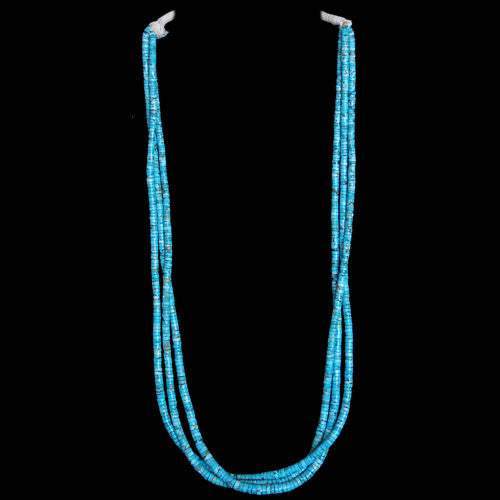
Santo Domingo Lone Mountain Turquoise 3 Strand Necklace - Ray Lovato (#110)
$16,500.00
Artist: Ray Lovato
Southwest Jewelry
35"
This magnificent three strand bead necklace was created by master lapidary artist Ray Lovato, and is cut from high-grade, natural, sky blue Lone Mountain turquoise. Lone Mountain is a hard, durable turquoise that has always been noted for holding its color. Among all “classic” Southwestern turquoise, only Lander Blue is considered more valuable. The Lone Mountain mine consists of a series of haphazard tunnels dug by miners chasing valuable veins. The mine was claimed by Lee Hand in 1920, first as the Blue Jay Mining Lode and later as Lone Mountain. In the 1960s, Lone Mountain was converted to a small open pit operations by Menliss Winfield, and to this day continues to be mined in that fashion. In 1979 Gene Waddell purchased the claim with the King family of Austin, Texas and Santa Fe, New Mexico. Gene has had several partners over the years, but the property has only been mined six of the last 28 years. Ray discovered this turquoise in a private collection and talked the owner into letting him purchase the stash. This necklace is a turquoise treasure if ever there was one.
We offer a 100% satisfaction guarantee on every purchase.
Lone Mountain Turquoise
The Lone Mountain turquoise mine is located near Tonapah, in Esmeralda County, Nevada. Since it is known for producing a high percentage of gem-grade turquoise, it is often referred to as a "sweet heart" mine. Originally established in 1920 by Lee Hand, the claim was initially called the Blue Jay Mining Lode. Later, after noting that so many other mines had been named Blue Jay, Hand changed its name to Lone Mountain.
In 1927, at a depth of about 40 feet, Bert Kopenhaver, who had leased the mine from Hand, found the beautiful spiderweb turquoise that made Lone Mountain one of the top mines in the Southwest. Although it has change hands several times over the years, the mine still produces a small amount of quality material. The Lone Mountain claim is currently owned by Gene Wadell and operated by Chris Lott.
Also known for exquisite, deep blue stones, the mine has historically produced some of the highest quality spiderweb turquoise in the world. "Fossil turquoise" has also been found in the mine. This was formed when ancient plants and sea shells dissolved, leaving only cavities that were later filled with turquoise deposits. Additionally, turquoise nuggets in moss agate have been found. Because of its extraordinary hard nature, Lone Mountain turquoise has the ability to retain its rich color and is therefore a valuable addition to any jewelry collection.
About the artist:

The gift of humor is a blessing to those who have it, and to those of us exposed to the comic. From an early age, Steve and I have been blessed with the humor of Santa Domingo artist Ray Lovato. Not only does Ray create exceptional jewelry, he does it with wit and comedy. He always has an aura of happiness around him, and this attitude seems to spread, like a California fog, to those who know him. In addition to his artistic talents, Ray is also a gifted salesman. When he pulls up in front of the trading post we know that there is a good possibility that we will soon be parting company with our available cash.
Related legends:
Precious Stones
Turquoise; Precious stones have symbolic implications. For example, turquoise if a "collective term for all the precious stones, wealth, or mixed offerings. Good fortune is attributed to this stone." Both white shell and turquoise are emphasized in Kinaalda? More about this legend
Ray and Melissa Lovato
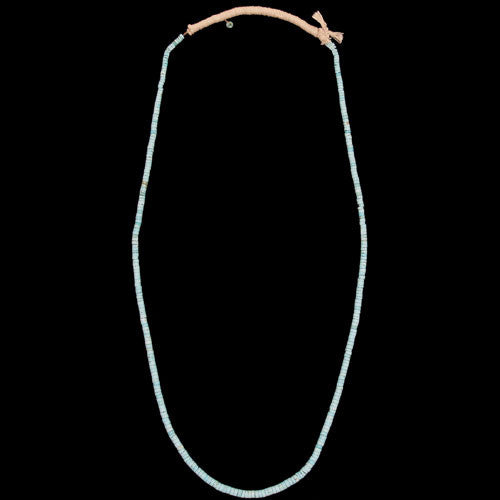
Santo Domingo Number 8 Turquoise Beaded Necklace - Ray and Melissa Lovato (#119)
$1,990.00

Santo Domingo Number 8 Turquoise Beaded Necklace - Ray and Melissa Lovato (#119)
$1,990.00
Artist: Ray and Melissa Lovato
Southwest Jewelry
Length: 32"
Width: 3 /16"
We offer a 100% satisfaction guarantee on every purchase.
Number 8 Turquoise
Located in the Lynn mining district (no. 19, pl. 1) in northern Eureka County, Nevada, the Number 8 mine is on the west side of the Tuscarora Range in the NW 1/4 sec. 4, T. 35 N., R. 50 E., 18 to 19 miles north - northeast of Dunphy. Host rocks for the Number 8 deposit consist of intensely altered quartz monzonite, shale, and thinly bedded black chert, which are complexly folded, faulted, and much altered. Turquoise is concentrated along quartz veins in the intrusive rock and along faults in the sedimentary rocks. The turquoise is mainly in a nodular form, but only about ten percent has been rated as good quality gem material. Of the ten claims in a 20-acre area, the Number 8 claimed by the Blue Star Company in Lander County is considered the finest example of the gold-webbed turquoise. The mine was depleted in 1961. Approximately 5,000 pounds were mined between 1929 and 1933. Almost all the turquoise produced is of the spider web-type, with the matrix varying from golden brown to black. The colors grade from very light blue to very dark blue, some with interesting hints of green. A number 8 turquoise of gem quality is considered to be very collectible.
A barber from Carlin whose name has been forgotten presumably discovered the number 8 mine about 1925; he made no attempt to mine the property. Earl Buffington and Lawrence Springer rediscovered the mine in 1929. They filed formal claim to the property and proceeded to mine turquoise in serious fashion, producing about 1,800 pounds of good stone the first year. In 1930 Ted Johnson bought Buffington's interest and during the next four years produced about 5,000 pounds of commercial stone. In 1935 Doc Wilson bought the number 8 mine from Johnson but did nothing with the property and the claim lapsed. Myron Clark relocated the claim and, after working it for a while, sold it to Lee Hand. Hand operated the mine for a short time, but dissatisfied with the quality of the stone, sold it to the five Edgar brothers who now own it. The Edgars extended operations and produced a considerable amount of fair-to-good turquoise.
In 1950, as most of the visible turquoise had been taken from the workings, the Edgars hired a contractor with bulldozer equipment to remove overburden from another part of the claim. A deposit of copper had been found on the property, and the Edgars thought they might mine copper if they did not find more turquoise. The bulldozer, after digging a pit about eight feet deep and 80 feet long, uncovered a deposit of some of the finest spider-web turquoise ever found in Nevada. The deposit was mostly in nodules, some of gigantic size. One nodule, perhaps the largest, weighed more than nine pounds. It was sold to C. G. Wallace, of Zuni, New Mexico, for $1,600.
The discovery proved to be a rather large-pocket and produced more than 1,600 pounds of the very highest grade turquoise before being worked out. Spurred by this find, the Edgars further explored the property, without finding any more spider-web turquoise of notable quantity. Other turquoise was discovered, however, of good commercial grade, sufficient to keep the mine in operation.
One of the largest pieces of turquoise and matrix in the modern world, perhaps the largest nodule ever uncovered, was discovered at the Number 8 mine on June 23, 1954, by T. G. Edgar, J. M. Edgar, and Marvin Symes. This specimen was 33 inches long, 18.5 inches wide, and seven inches thick. Cleaned and polished it weighed 150 pounds. The nodule was of excellent texture, good color and hardness, and ranked with any turquoise of good commercial grade.
About the artist:

The gift of humor is a blessing to those who have it, and to those of us exposed to the comic. From an early age, Steve and I have been blessed with the humor of Santa Domingo artist Ray Lovato. Not only does Ray create exceptional jewelry, he does it with wit and comedy. He always has an aura of happiness around him, and this attitude seems to spread, like a California fog, to those who know him. In addition to his artistic talents, Ray is also a gifted salesman. When he pulls up in front of the trading post we know that there is a good possibility that we will soon be parting company with our available cash.
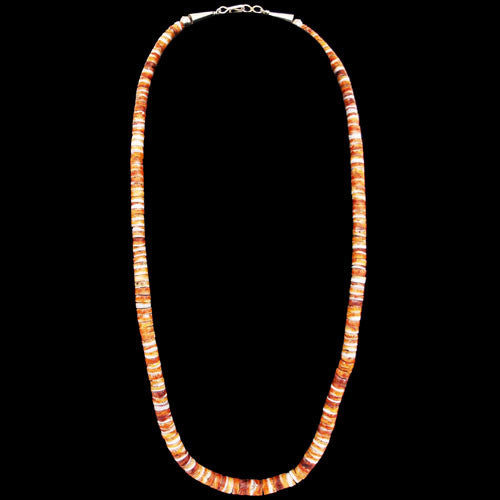
Santo Domingo Orange Spiny Oyster Necklace - Ray Lovato (#127)
$600.00
Artist: Ray Lovato
Southwest Jewelry
20 1/2" long
For a glimpse of good, old-fashioned bead craft one only need look to Ray Lovato. This master Santa Domingo artist retains and reflects the lessons learned from his ancestors to create modern marvels. Using Spondylus shells gathered from the Gulf of Mexico, Ray hand grinds each bead individually to achieve such serpentine creations. For an artist with a grip on the past and an eye on the future we simply look to Ray.
We offer a 100% satisfaction guarantee on every purchase.
About the artist:

The gift of humor is a blessing to those who have it, and to those of us exposed to the comic. From an early age, Steve and I have been blessed with the humor of Santa Domingo artist Ray Lovato. Not only does Ray create exceptional jewelry, he does it with wit and comedy. He always has an aura of happiness around him, and this attitude seems to spread, like a California fog, to those who know him. In addition to his artistic talents, Ray is also a gifted salesman. When he pulls up in front of the trading post we know that there is a good possibility that we will soon be parting company with our available cash.
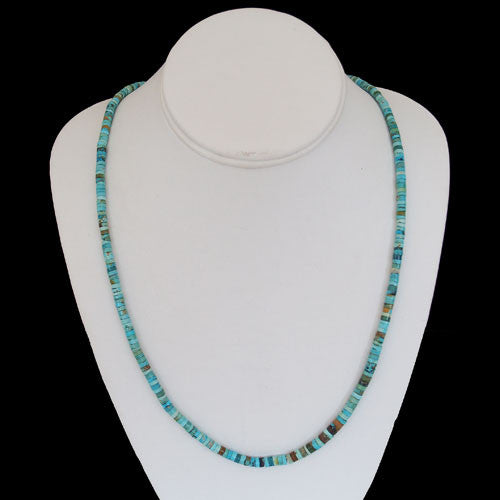
Santo Domingo Royston Turquoise Handmade Bead Necklace - Melissa Lovato (#06)
$2,500.00
Artist: Melissa Lovato
31 1/2" long
Melissa Lovato has taken up the traditional bead making skills of her famous father, Ray. Using Royston turquoise she has cut and polished until a fabulous string of beads emerged. Apparently Melissa has been a diligent understudy, because her craftsperson skills are highly developed. This is a great strand that will only get better with time.
Royston Turquoise
The Royston Mining District lies on the Nye-Esmerelda County line, about 24 miles northwest of Tonopah, Nevada. In this area, turquoise mines are scattered for nearly a mile along a shallow canyon. Because it involves many small producers, the Royston district is one of the better-known turquoise mining areas in Nevada. Three of the district's more important turquoise mines are the Royal Blue, Bunker Hill and the Oscar Wehrend.
The Royal Blue mine constitutes the main turquoise workings in the district. This turquoise shows as fine-grained, altered porphyry, which is soft in places, although much of it has been hardened by silification. The turquoise is found principally in veinlets and seams, with minor lenses and nodules. The veinlets and lenses range from a fraction of an inch to more than an inch in thickness. Masses of turquoise, filling brecciated matrix, have, however, been found more than five inches thick. Lens shaped pieces of turquoise weighing an ounce or two are not uncommon, and one piece weighing nearly a pound and a half were found.
Royston turquoise ranges in color from dark and pale blue to various shades of green. Some of the dark blue turquoise has a slightly greenish cast, and some is nearly pure blue in color. The dark blue turquoise and that with a greenish cast are very fine grained and hard; the lighter colored ore is generally softer. The best turquoise is often found in limonite stained rock, and the pale blue, softer turquoise is found in light colored, softer porphyry. The quality of the best pure blue stones from the Royal Blue is equal to that found in any American mine and the matrix is especially fine.
The hard turquoise veins and nuggets are coated with a crust or stain of dark to light shading, and at times include a yellow limonite. This stain penetrates the turquoise along seams and branching cracks, producing attractive patterns and contrasts of color. Some large specimens have consisted of a patchwork of dark blue with a slightly greenish tint, marked in places with a very dark red-brown matrix. These cut gems can exhibit exceedingly wide variations of shading, and the matrix contrasts are often striking. Great spider webbing in green or blue nuggets and unusual scenic turquoise pieces are a hallmark of Royston
Two prospectors named Workman and Davis, who later sold the mine to William Petry for $3,000.00, discovered the mine in 1902. Petry improved the mine to the point of assuring its production, and, in 1907, sold it to The Himalaya Mining Co., which was owned by Julius Tannenbaum of Los Angeles and New York. Tannenbaum owned a number of mines in Nevada and California. During 1908 and 1909, the property was systematically and actively worked under the directions of Julius Goldsmith, Tanenbaum's son-in-law. Tannenbaum died suddenly about 1910, and Goldsmith hurried east to settle the estate. Shortly afterwards, he ordered operations abandoned and about 1911 sold the mine back to Petry. Petry and W. I. Miller, who had been Petry's mine boss, operated the mine for a time, and then leased it to Lee Hand and Bert Kopenhaver. Hand and Kopenhaver worked the mine dumps for a time, and then bought the mine outright from Petry. Kopenhaver later sold his share to Charley Bona. Hand and Bona worked the mine periodically, and in 1936 Bona sold his interest to Ted Johnson. In 1940 Johnson sold his share to Lee Hand.
The Otteson family now works the mine. The Otteson story began in 1944 with Lynn Otteson. Lynn brought his family to Nevada to mine turquoise and leased his first Royston claim from Lee Hand. At that time, Hand owned approximately 30 claims in the Royston district. The Otteson family has owned or leased turquoise claims in this district for the past 60 years. The Royal Blue mine has been one of the major turquoise producers in the state of Nevada. For some time, the mine produced as much as 1,250 pounds of turquoise a month, and several times has exceeded that amount.
Petry, at the time he sold the mine to Hand and Kopenhaver, declared that the Royal Blue had produced more gem quality turquoise than any mine in the United States. He placed the value of cut stones taken from the mine at more than $5 million. There is no adequate estimate of the value of gems produced from the mine in the years since that time.
The Bunker Hill is about half a mile north of The Royal Blue. In this mine, turquoise occurs in altered quartzite and ranges from royal blue to greenish blue with brown with white matrix. Turquoise is mainly in the form of slabs from 1/16 of an inch to a full inch thick. The mine was discovered in 1927 by Roy Palfreyman and Bert Kopenhaver, and was originally opened as a small shaft about 20 feet deep. As the turquoise was unearthed, the shaft was widened along the seam into a long stope, which was eventually opened into a glory hole. Polfreyman and Kopenhaver took out about $30,000 worth of turquoise, then sold to the owners of the Royal Blue mine, who produced about $75,000 worth of material. The mine eventually was incorporated into the Royal Blue group of claims.
The Oscar Wehrend mine, in the Royston district, is about 1/3 of a mile from the main workings of the Royal Blue. The turquoise is in highly altered rocks, where it forms seams, coatings and nodules as large as 2 inches thick. It is mostly soft, pale, and not of very good quality. Its color and hardness can, however, be improved by artificial means. Oscar Wehrend discovered the deposit in 1909, but Lee Hand conducted much of the work. Production from the property has been small.
The Royston Mine was originally worked as a silver mine in the late 1800s, Large deposits of high quality turquoise led Tiffany's of New York to incorporate quality green and blue turquoise stones from the Royston Hills into their jewelry lines prior to WWII. There was a brief surge of Royston turquoise production in the 1970s, and the Royston district is still producing limited amounts of high quality turquoise. The turquoise currently being produced from the Royston district is mined by Dean and Danny Otteson, and is coming from the Royal Royston claim.
Related legends:
Precious Stones Turquoise; Precious stones have symbolic implications. For example, turquoise if a "collective term for all the precious stones, wealth, or mixed offerings. Good fortune is attributed to this stone." Both white shell and turquoise are emphasized in Kinaalda? More about this legend
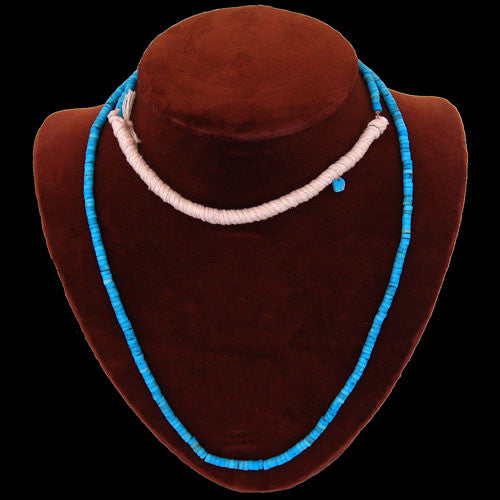
Santo Domingo Sleeping Beauty Turquoise Bead Necklace - Melissa Lovato (#05)
$4,500.00
Artist: Melissa Lovato
Southwest Jewelry
35" long
6" Squaw Wrap
Nobody hand rolls natural turquoise beads like Ray Lovato, nobody except Ray's daughter Melissa. From a young age Melissa worked under her father's tutelage, and has become a talented artist in her own right. This necklace of high-grade, natural Sleeping Beauty turquoise proves Melissa is a prodigy. You go girl!
We offer a 100% satisfaction guarantee on every purchase.
Sleeping Beauty Turquoise
The Sleeping Beauty turquoise mine is located seven miles from Globe, Arizona. The mine is one of the largest producers of turquoise in North America. The mine, and the turquoise extracted from it, derives its name from Sleeping Beauty Mountain, which at one time was part of the Copper Cities operation. The center of the copper mine is located at approximately 33o24"13.23"N. 110o53'34. 60"W, at an elevation of 1224 feet. Sleeping Beauty Turquoise Mining is presently owned and operated by Monty Nichols.
For many centuries before the first Europeans made their way into Arizona, turquoise was being mined on the slopes of Sleeping Beauty Mountain. The Salado and other ancient peoples mined the beautiful sky stone from several surface outcroppings located in the vicinity, including Pinto Valley. It is believed that Spanish explorers were the first Europeans to locate the source of Sleeping Beauty sometime around the 1860s. By the 1870s, small underground mines pockmarked the hills surrounding present day Globe.
Cities Service Company started the Copper Cities Mine (commonly called the Sleeping Beauty Mine) in 1952 and operated it until the Pinto Valley mine opened in 1972. During the 1960s, L.W. Hardy had the contract to mine turquoise, both at Sleeping Beauty and at Castle Dome, later called the Pinto Valley Mine. Formerly a meat cutter at a market in Miami, Hardy recognized early on that turquoise was more valuable as a gemstone than the associated copper.
By the time the turquoise boom began, Hardy had contracts with mining companies in Miami, Kingman and elsewhere. He also developed a method for stabilizing low-grade, porous turquoise with pressure-impregnated hot acrylic resin, which hardened the stone and improved the color.
Hardy's mining methods were primitive when compared with current operations. Hardy's workers sat in a ditch ripped by a bulldozer and hand picked the stone from waste-rock. Hardy mined turquoise at Sleeping Beauty for 22 years, getting about 45 percent recovery, and leaving the rest in waste dumps.
Monty Nichols received the contract to mine Sleeping Beauty turquoise in 1988, and began using modern mining methods to develop the property. Nichols drills and blasts the overburden, hauling it to the abandoned Copper Cities pit, which now contains the recycled tailings from Miami Copper Company's No. 5 tailing dam. The old dam dominated the eastern skyline of downtown Miami until recently. The year Nichols acquired the contract; he began a two-year project to remove 5,000.000 tons of overburden. Located half way up the side of an open pit mine, the narrow turquoise-bearing zone has about 400 feet of hard waste rock on top of it. In order to move sideways into the ore-body, a whole slice of the mountain had to be removed.
To avoid fracturing the turquoise, Nichols was careful not to blast too near the turquoise-bearing strata. That layer is more crumbly, so the miners can rip it and dump it over screens, separating the material by size. No crushers are used, again to avoid fracturing the gemstone, and the different sized rock is hauled up to a wide mine bench where conveyor belts move the material through three buildings. There, workers handpick turquoise from the broken rock. The buildings are vented with filtered air to eliminate workers' exposure to dust, and well insulated to keep them comfortable in any weather. It is a far cry from the old methods of mining. Anywhere from 30 to 40 people work at the mine at any one time, depending on how much mining there is to do.
Fifty years ago, mine workers filled lunch buckets with the colorful rock, even though it was reason for immediate termination. Old habits die hard, and some people still think it is okay to sneak in and try to pick turquoise. As a result, security is tight in and around the mine. Motion detectors, night vision cameras and 24/7 roving patrols are used, so the only turquoise leaving the property now is being shipped to markets around the world.
Italy is the largest volume buyer of Sleeping Beauty turquoise, with Germany and Hong Kong following closely behind. These customers buy the best grade for their exclusive jewelry. Jewelry makers in India and Spain also receive Sleeping Beauty turquoise, while in the U.S., Gallup and Albuquerque are the largest consumers.
The Sleeping Beauty turquoise mine produces a uniform light to medium blue turquoise with rare finds of deep, dark blue. Because of its uniformity, it has been a favorite of the Zuni Pueblo. Zuni silversmiths often use it in channel inlay and various types of cluster work that require large numbers of small, perfectly matched stones. The Sleeping Beauty mine has been one of the larger producers of rough turquoise in the United States, although today much less good turquoise is being produced than in the past.
Sleeping Beauty turquoise is noted for its solid, light blue color with no matrix; the host rock is usually granite. Nichols says the mine is producing about 1,600 pounds a month. Of that, only four percent is natural; most of the turquoise from the mine is altered in some way. Most is enhanced, which is more expensive than stabilization, and sold to large distributors in this country and Europe. Currently most of the turquoise that comes from the mine is from the tons of tailings piles that have been accumulating for decades.
The best of the Sleeping Beauty turquoise is comparable to that found in the Middle East. It is thought that large quantities of Sleeping Beauty turquoise is taken overseas and smuggled into, then out of, Iran to be sold as “Persian” turquoise.
About the artist:

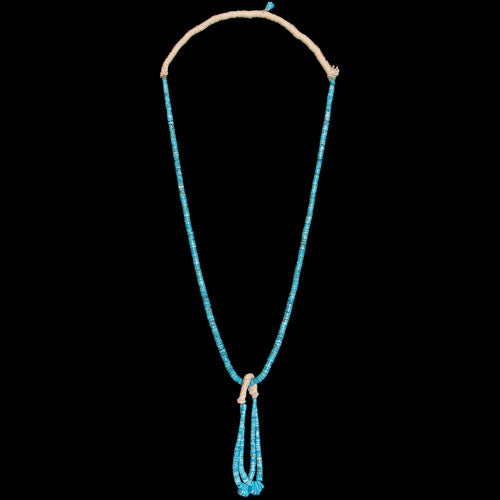
Santo Domingo Sleeping Beauty Turquoise Necklace w/ Jacla - Ray Lovato (#120)
$3,900.00
Artist: Ray Lovato
Southwest Jewelry
33" long
Natural Sleeping Beauty turquoise is the basis for this Ray and Melissa Lovato Santo Domingo bead necklace. Ray, and his daughter Melissa, are known far and wide for their work. Many argue Ray’s necklaces are the best contemporary examples of old style Santo Domingo beads available. We agree, and collect them whenever we can. You might want to do the same.
We offer a 100% satisfaction guarantee on every purchase.
Sleeping Beauty Turquoise
The Sleeping Beauty turquoise mine is located seven miles from Globe, Arizona. The mine is one of the largest producers of turquoise in North America. The mine, and the turquoise extracted from it, derives its name from Sleeping Beauty Mountain, which at one time was part of the Copper Cities operation. The center of the copper mine is located at approximately 33o24"13.23"N. 110o53'34. 60"W, at an elevation of 1224 feet. Sleeping Beauty Turquoise Mining is presently owned and operated by Monty Nichols.
For many centuries before the first Europeans made their way into Arizona, turquoise was being mined on the slopes of Sleeping Beauty Mountain. The Salado and other ancient peoples mined the beautiful sky stone from several surface outcroppings located in the vicinity, including Pinto Valley. It is believed that Spanish explorers were the first Europeans to locate the source of Sleeping Beauty sometime around the 1860s. By the 1870s, small underground mines pockmarked the hills surrounding present day Globe.
Cities Service Company started the Copper Cities Mine (commonly called the Sleeping Beauty Mine) in 1952 and operated it until the Pinto Valley mine opened in 1972. During the 1960s, L.W. Hardy had the contract to mine turquoise, both at Sleeping Beauty and at Castle Dome, later called the Pinto Valley Mine. Formerly a meat cutter at a market in Miami, Hardy recognized early on that turquoise was more valuable as a gemstone than the associated copper.
By the time the turquoise boom began, Hardy had contracts with mining companies in Miami, Kingman and elsewhere. He also developed a method for stabilizing low-grade, porous turquoise with pressure-impregnated hot acrylic resin, which hardened the stone and improved the color.
Hardy's mining methods were primitive when compared with current operations. Hardy's workers sat in a ditch ripped by a bulldozer and hand picked the stone from waste-rock. Hardy mined turquoise at Sleeping Beauty for 22 years, getting about 45 percent recovery, and leaving the rest in waste dumps.
Monty Nichols received the contract to mine Sleeping Beauty turquoise in 1988, and began using modern mining methods to develop the property. Nichols drills and blasts the overburden, hauling it to the abandoned Copper Cities pit, which now contains the recycled tailings from Miami Copper Company's No. 5 tailing dam. The old dam dominated the eastern skyline of downtown Miami until recently. The year Nichols acquired the contract; he began a two-year project to remove 5,000.000 tons of overburden. Located half way up the side of an open pit mine, the narrow turquoise-bearing zone has about 400 feet of hard waste rock on top of it. In order to move sideways into the ore-body, a whole slice of the mountain had to be removed.
To avoid fracturing the turquoise, Nichols was careful not to blast too near the turquoise-bearing strata. That layer is more crumbly, so the miners can rip it and dump it over screens, separating the material by size. No crushers are used, again to avoid fracturing the gemstone, and the different sized rock is hauled up to a wide mine bench where conveyor belts move the material through three buildings. There, workers handpick turquoise from the broken rock. The buildings are vented with filtered air to eliminate workers' exposure to dust, and well insulated to keep them comfortable in any weather. It is a far cry from the old methods of mining. Anywhere from 30 to 40 people work at the mine at any one time, depending on how much mining there is to do.
Fifty years ago, mine workers filled lunch buckets with the colorful rock, even though it was reason for immediate termination. Old habits die hard, and some people still think it is okay to sneak in and try to pick turquoise. As a result, security is tight in and around the mine. Motion detectors, night vision cameras and 24/7 roving patrols are used, so the only turquoise leaving the property now is being shipped to markets around the world.
Italy is the largest volume buyer of Sleeping Beauty turquoise, with Germany and Hong Kong following closely behind. These customers buy the best grade for their exclusive jewelry. Jewelry makers in India and Spain also receive Sleeping Beauty turquoise, while in the U.S., Gallup and Albuquerque are the largest consumers.
The Sleeping Beauty turquoise mine produces a uniform light to medium blue turquoise with rare finds of deep, dark blue. Because of its uniformity, it has been a favorite of the Zuni Pueblo. Zuni silversmiths often use it in channel inlay and various types of cluster work that require large numbers of small, perfectly matched stones. The Sleeping Beauty mine has been one of the larger producers of rough turquoise in the United States, although today much less good turquoise is being produced than in the past.
Sleeping Beauty turquoise is noted for its solid, light blue color with no matrix; the host rock is usually granite. Nichols says the mine is producing about 1,600 pounds a month. Of that, only four percent is natural; most of the turquoise from the mine is altered in some way. Most is enhanced, which is more expensive than stabilization, and sold to large distributors in this country and Europe. Currently most of the turquoise that comes from the mine is from the tons of tailings piles that have been accumulating for decades.
The best of the Sleeping Beauty turquoise is comparable to that found in the Middle East. It is thought that large quantities of Sleeping Beauty turquoise is taken overseas and smuggled into, then out of, Iran to be sold as “Persian” turquoise.
About the artist:

The gift of humor is a blessing to those who have it, and to those of us exposed to the comic. From an early age, Steve and I have been blessed with the humor of Santa Domingo artist Ray Lovato. Not only does Ray create exceptional jewelry, he does it with wit and comedy. He always has an aura of happiness around him, and this attitude seems to spread, like a California fog, to those who know him. In addition to his artistic talents, Ray is also a gifted salesman. When he pulls up in front of the trading post we know that there is a good possibility that we will soon be parting company with our available cash.
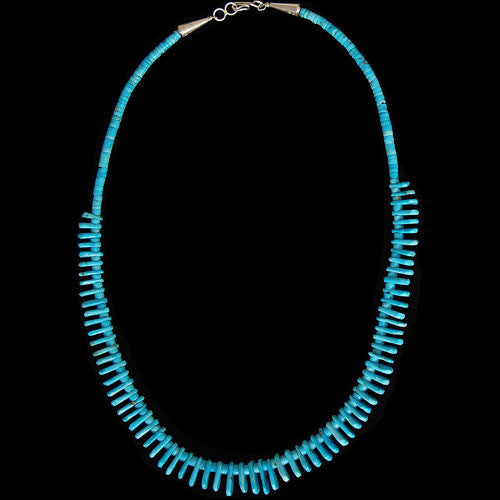
Santo Domingo Sleeping Beauty Turquoise Tab Necklace - Melissa Lovato (#04)
$1,800.00
Artist: Melissa Lovato
Southwest Jewelry
20 1/2"
Except for a few silver findings Melissa Lovato, Ray Lovato’s daughter, made this “tab necklace” that looks like it could have been made eons ago. Using Sleeping Beauty turquoise from the Inspiration copper mine in Globe, Arizona, Melissa utilized the skills passed down to her from her dad to fashion a necklace that has just the right balance between the rough and the finished. This is a great piece of jewelry with real history behind it.
We offer a 100% satisfaction guarantee on every purchase.
Sleeping Beauty Turquoise
The Sleeping Beauty turquoise mine is located seven miles from Globe, Arizona. The mine is one of the largest producers of turquoise in North America. The mine, and the turquoise extracted from it, derives its name from Sleeping Beauty Mountain, which at one time was part of the Copper Cities operation. The center of the copper mine is located at approximately 33o24"13.23"N. 110o53'34. 60"W, at an elevation of 1224 feet. Sleeping Beauty Turquoise Mining is presently owned and operated by Monty Nichols.
For many centuries before the first Europeans made their way into Arizona, turquoise was being mined on the slopes of Sleeping Beauty Mountain. The Salado and other ancient peoples mined the beautiful sky stone from several surface outcroppings located in the vicinity, including Pinto Valley. It is believed that Spanish explorers were the first Europeans to locate the source of Sleeping Beauty sometime around the 1860s. By the 1870s, small underground mines pockmarked the hills surrounding present day Globe.
Cities Service Company started the Copper Cities Mine (commonly called the Sleeping Beauty Mine) in 1952 and operated it until the Pinto Valley mine opened in 1972. During the 1960s, L.W. Hardy had the contract to mine turquoise, both at Sleeping Beauty and at Castle Dome, later called the Pinto Valley Mine. Formerly a meat cutter at a market in Miami, Hardy recognized early on that turquoise was more valuable as a gemstone than the associated copper.
By the time the turquoise boom began, Hardy had contracts with mining companies in Miami, Kingman and elsewhere. He also developed a method for stabilizing low-grade, porous turquoise with pressure-impregnated hot acrylic resin, which hardened the stone and improved the color.
Hardy's mining methods were primitive when compared with current operations. Hardy's workers sat in a ditch ripped by a bulldozer and hand picked the stone from waste-rock. Hardy mined turquoise at Sleeping Beauty for 22 years, getting about 45 percent recovery, and leaving the rest in waste dumps.
Monty Nichols received the contract to mine Sleeping Beauty turquoise in 1988, and began using modern mining methods to develop the property. Nichols drills and blasts the overburden, hauling it to the abandoned Copper Cities pit, which now contains the recycled tailings from Miami Copper Company's No. 5 tailing dam. The old dam dominated the eastern skyline of downtown Miami until recently. The year Nichols acquired the contract; he began a two-year project to remove 5,000.000 tons of overburden. Located half way up the side of an open pit mine, the narrow turquoise-bearing zone has about 400 feet of hard waste rock on top of it. In order to move sideways into the ore-body, a whole slice of the mountain had to be removed.
To avoid fracturing the turquoise, Nichols was careful not to blast too near the turquoise-bearing strata. That layer is more crumbly, so the miners can rip it and dump it over screens, separating the material by size. No crushers are used, again to avoid fracturing the gemstone, and the different sized rock is hauled up to a wide mine bench where conveyor belts move the material through three buildings. There, workers handpick turquoise from the broken rock. The buildings are vented with filtered air to eliminate workers' exposure to dust, and well insulated to keep them comfortable in any weather. It is a far cry from the old methods of mining. Anywhere from 30 to 40 people work at the mine at any one time, depending on how much mining there is to do.
Fifty years ago, mine workers filled lunch buckets with the colorful rock, even though it was reason for immediate termination. Old habits die hard, and some people still think it is okay to sneak in and try to pick turquoise. As a result, security is tight in and around the mine. Motion detectors, night vision cameras and 24/7 roving patrols are used, so the only turquoise leaving the property now is being shipped to markets around the world.
Italy is the largest volume buyer of Sleeping Beauty turquoise, with Germany and Hong Kong following closely behind. These customers buy the best grade for their exclusive jewelry. Jewelry makers in India and Spain also receive Sleeping Beauty turquoise, while in the U.S., Gallup and Albuquerque are the largest consumers.
The Sleeping Beauty turquoise mine produces a uniform light to medium blue turquoise with rare finds of deep, dark blue. Because of its uniformity, it has been a favorite of the Zuni Pueblo. Zuni silversmiths often use it in channel inlay and various types of cluster work that require large numbers of small, perfectly matched stones. The Sleeping Beauty mine has been one of the larger producers of rough turquoise in the United States, although today much less good turquoise is being produced than in the past.
Sleeping Beauty turquoise is noted for its solid, light blue color with no matrix; the host rock is usually granite. Nichols says the mine is producing about 1,600 pounds a month. Of that, only four percent is natural; most of the turquoise from the mine is altered in some way. Most is enhanced, which is more expensive than stabilization, and sold to large distributors in this country and Europe. Currently most of the turquoise that comes from the mine is from the tons of tailings piles that have been accumulating for decades.
The best of the Sleeping Beauty turquoise is comparable to that found in the Middle East. It is thought that large quantities of Sleeping Beauty turquoise is taken overseas and smuggled into, then out of, Iran to be sold as “Persian” turquoise.
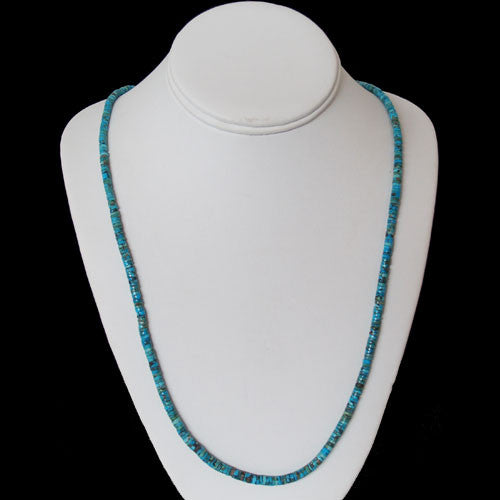
Santo Domingo Tiny Handmade Gem Grade Villa Grove Turquoise Bead Necklace - Ray Lovato (#134)
$6,250.00
Artist: Ray Lovato
Total length: 32 1/2"
High grade, natural Villa Grove turquoise is one of the most rare and sought after turquoise on the market today. George Musik mined the turquoise in this Ray Lovato necklace; sometime in the span of time he owned and operated the mine. When Randy Christenson purchased the Villa Grove mine, from George, he acquired the rough turquoise as well. We bought the stone from Randy and passed it on to Santa Domingo lapidary artist Ray Lovato, who cut these magnificent beads. If that is not a joyful trail of events we do not know what is.
Villa Grove Turquoise
The Villa Grove Turquoise Mine, aka; The Hall Mine, is located seven miles northwest of the town of Villa Grove, in the North end of the San Luis Valley of Colorado, at 10,000 feet in elevation. The Villa Grove turquoise mine showed signs of being worked by the Ancient Native American's. It was rediscovered sometime in the 1890’s and mined for copper with turquoise operations beginning in the early 1900’s. The Villa Grove mine was first mentioned in 1893. The largest dig site in the area is difficult to mine because it fills with water from a nearby spring. The mines largest production occurred during the 1930s through the 1950s when Bob Hall, Menalis Winfield, George Musik and others owned it. Randy Christenson purchased the Mine from George Musik in 2000. Randy is producing small amounts of Villa Grove turquoise at this time.
About the artist:

The gift of humor is a blessing to those who have it, and to those of us exposed to the comic. From an early age, Steve and I have been blessed with the humor of Santa Domingo artist Ray Lovato. Not only does Ray create exceptional jewelry, he does it with wit and comedy. He always has an aura of happiness around him, and this attitude seems to spread, like a California fog, to those who know him. In addition to his artistic talents, Ray is also a gifted salesman. When he pulls up in front of the trading post we know that there is a good possibility that we will soon be parting company with our available cash.
Related legends:
Precious Stones
Turquoise; Precious stones have symbolic implications. For example, turquoise if a "collective term for all the precious stones, wealth, or mixed offerings. Good fortune is attributed to this stone." Both white shell and turquoise are emphasized in Kinaalda? More about this legend
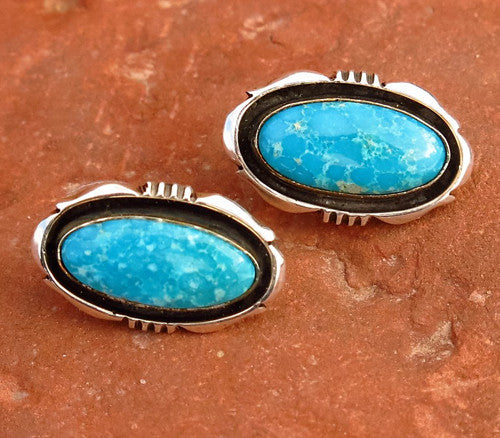
Searchlight Turquoise and Sterling Silver Post Earrings - Will Denetdale (#279)
$275.00
Artist: Will Denetdale
The Searchlight, Nevada turquoise mine has been around long enough to have had numerous owners and an equal number of names. The bottom line is that this turquoise is very fine. The matched pair of stones in these earrings came from the same specimen. The stones are completely natural and of a very high grade. Will Denetdale’s shadowbox settings were the perfect choice to highlight the Searchlight stones. This combination of sterling silver and sky stone makes for an exceptional set of earrings.
1" x 1 1/2"
See full biography Not on new site yet
See all items by Will Denetdale OK
Related categories:
Navajo Jewelry See all items in this category Not on new site yet (DELETE THIS??)
Add to Wish List (required login): Not on new site yet
Certificate of Authenticity Not on new site yet

Silver Buffalo Pendant w/ Turquoise accents - Robert Taylor (#023)
$315.00
Artist: Robert Taylor
Navajo Jewelry
Sterling Silver Overlay Buffalo Pendant with Turquoise accents
1 1/4" tall x 1 1/4" wide
We offer a 100% satisfaction guarantee on every purchase.
About the artist:

Robert Taylor - Silver & Goldsmith:
"Cluster, channel, leaf, inlay, casting... I've done about everything," Robert Taylor talks about his silver and goldsmithing, "There's a lot of artists that do it." And then he confides the reason he has set himself apart from other craftsmen. "I didn't really get anywhere until I decided to design my own style."
Related legends:
Silversmith Work
When and how the Navajo acquired the art of working metals is unknown but there are reasons for supposing that it was introduced among them, or at least more developed and improved upon by them, since the time they have occupied their present country?
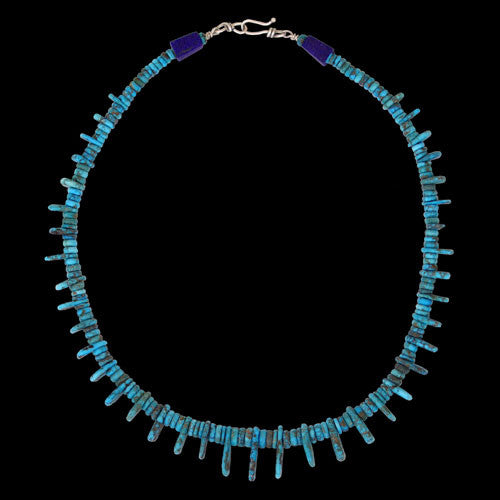
Southwest Gem Grade Burnham Turquoise Necklace - Bruce Eckhardt (#17)
$4,750.00
Artist: Bruce Eckhardt
Southwest Jewelry
Handcut, shaped and strung natural, gem grade Burnham turquoise necklace
23 1/2" long
Bruce Woods and his D-9 Caterpillar tractor have been scraping off that hilltop, near Austin, Nevada, for quite some time now. On rare occasion he uncovers a trace of super high grade, natural material that gets those of us interested in such things rather excited. Such was the case with the Burnham turquoise found in this tab necklace. Bruce Eckhardt just happened to be trippin' by the mine soon after Brother Woods excavated this cache of beautifully colored and matrixed material. Lucky for Bruce and Bruce, beneficial for us and fortuitous for the world of individuals aroused by top grade turquoise.
We offer a 100% satisfaction guarantee on every purchase.
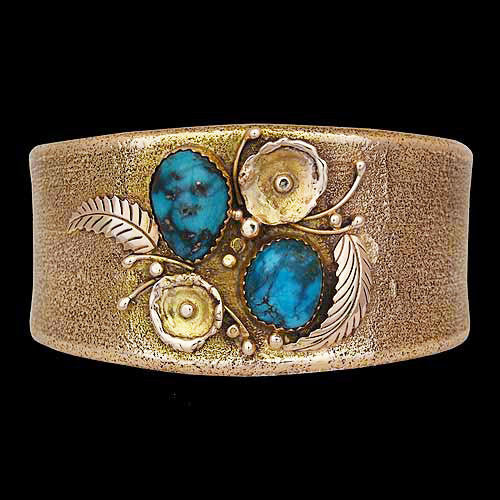
Southwestern 14K Gold & Bisbee Turquoise Bracelet - Don Dale (#04)
$4,250.00
Artist: Don Dale
Southwest Jewelry
6 1/4" Total Circumference
5 1/2" Inner Circumference
1" Opening
Don Dale is a transplant from the Missouri hill country. He is a self-taught silver and goldsmith who has become a master. Don has been generous enough to share his skills with numerous other artists, which has helped our local artist community a great deal. This 14k gold, Tufa cast bracelet is set with two exquisitely matched cabochons of gem-grade Bisbee turquoise. The saturation and depth of color in these stones, along with a stunning matrix pattern make for a lively and exciting display of this world-famous mineral. Top-quality workmanship with outrageous turquoise best describes this piece.
We offer a 100% satisfaction guarantee on every purchase.
Bisbee Turquoise
Bisbee turquoise is considered one of the classics. The most recognized variety is a dark lavender blue color with a deep chocolate brown to black matrix. As with all turquoise, there is a wide variety of quality from the Bisbee mine; color and matrix patterns vary a great deal. Some of the most distinctively recognizable Indian jewelry has been set and photographed containing classic Bisbee turquoise. The most productive period of the Bisbee turquoise mine was the 1950's and 1960's. Anything coming from the mine these days is scavenged from the old dumps. The mine has been closed since the early 1970's and is currently owned by Phelps Dodge Corp. Bisbee Mine. Arizona, Cochise County. Turquoise is found in the open pit copper mine. (The Lavender Pit) Some very fine quality, hard turquoise is found here with good color and beautiful dark-colored matrix. It is found as stringers up to a few inches wide; small nugget-like masses in granite and quartzite; and minute stringers in massive pyrite.
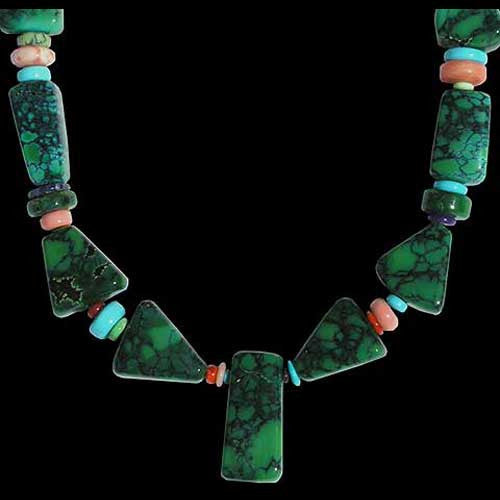
Southwestern Hobe Chinese Turquoise Necklace - Kai Gallagher (#04)
$3,400.00
Artist: Kai Gallagher
Southwestern Turquoise Jewelry
Natural Gem Quality Hobe Chinese
Turquoise Necklace with 14k Gold Clasps
Necklace - 18 1/2" long
Center stone - 1 1/4" tall x 5/8" wide
600 Carats
We offer a 100% satisfaction guarantee on every purchase.
About the artist:


Sterling Silver Broach w/ Navajo Rug Design - Robert Taylor (#29)
$525.00
Artist: Robert Taylor
Navajo Jewelry
Sterling Silver Broach w/ Navajo Rug Design
1 9/16" x 2 1/4"
Robert Taylor has crafted an unusual brooch based on the old-time peace medals handed out by the United States government in the mid to late 1800's. These symbols of accord and commitment were given to Navajo tribal leaders after signing the latest and most comprehensive peace treaty. New and clever ideas don't occur very often in the jewelry trade, but Robert has latched onto one here. The Navajo people may have been bamboozled out of their most prized real estate, but they are having the last laugh. With the discovery of gas and oil under what was once considered worthless land, they have found a bit of peace in the income allowed by an inconspicuous buried treasure.
We offer a 100% satisfaction guarantee on every purchase.
About the artist:

Robert Taylor - Silver & Goldsmith:
"Cluster, channel, leaf, inlay, casting... I've done about everything," Robert Taylor talks about his silver and goldsmithing, "There's a lot of artists that do it." And then he confides the reason he has set himself apart from other craftsmen. "I didn't really get anywhere until I decided to design my own style."
Related legends:
Silversmith Work
When and how the Navajo acquired the art of working metals is unknown but there are reasons for supposing that it was introduced among them, or at least more developed and improved upon by them, since the time they have occupied their present country?
Weaving
After the medicine woman told the people about the prayersticks she told them that there was a place in the underworld where two rivers crossed. It was called ni tqin'kae tsosi, fine fiber cotton (Indian hemp). There were two persons who brought the seed of that plant, they were spiders. They said that the people were to use the plant instead of skins for their clothing. So this seed was planted in the earth? More about this legend
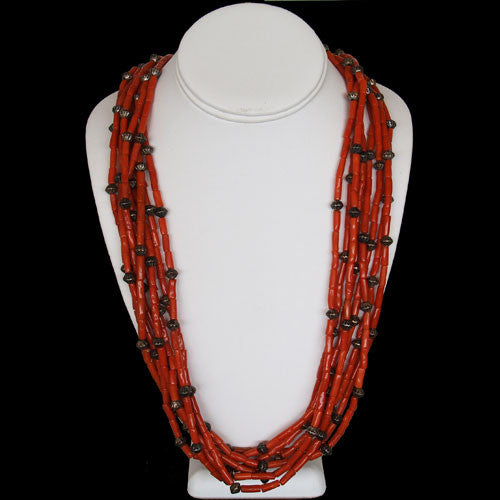
Stunning 8 Strand Mediterranean Coral Necklace (#56)
$2,900.00
33 1/2" long
Indians began trading with the Spanish as early as the 1400s. Soon thereafter, coral became a desired commodity. Coral strands such as these were imported from the Mediterranean in the 1970s. These have an attractive orange/red color and are interspersed with sterling silver beads. The "squaw wrap" collar is done with chrome colored leather, which makes for a soft and comfortable feel around the neck.
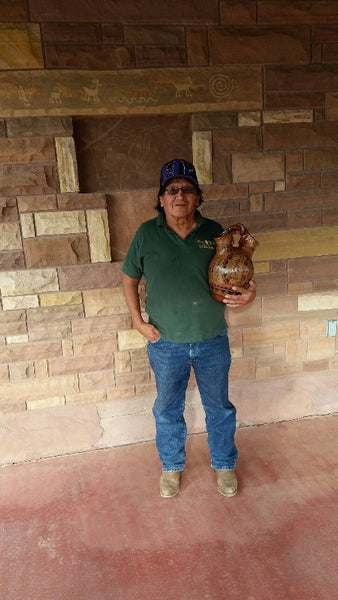
TESTING: some gift under $200
$10.00
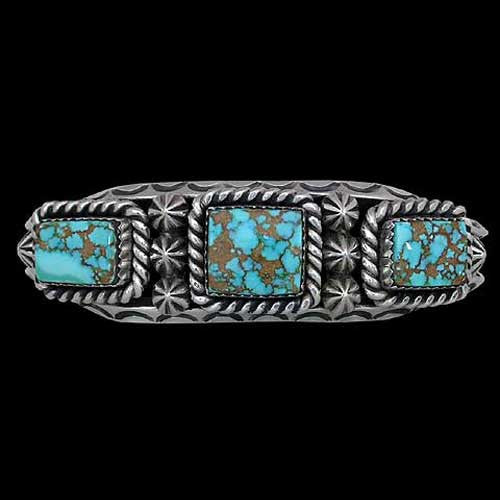
Three Stone Paiute Turquoise Bracelet - Toby Henderson (#063)
$1,250.00
Artist: Toby Henderson
Navajo Silver and Turquoise Jewelry
Hand Stamped Sterling Silver Bracelet
set with Natural Paiute Turquoise
Size - 6 3/4
Opening - 1"
Inner Circumference - 5 3/4"
We offer a 100% satisfaction guarantee on every purchase.
The Paiute turquoise mine consists of a series of nine full claims that run along the southern and western portion of a rock-strewn and sage brush encrusted central Nevada hillside. Down the southern slope and to the southwest about a half mile, nestled in a small valley dotted with juniper trees, is the Damele mine.
Paiute turquoise forms in veins and occasionally as nuggets in carbonaceous chert and diatomaceous earth. Since it is relatively new to the market, Paiute is a less well known stone. Because of the high quality turquoise the mine produces, however, it will certainly become a strong contender in the contemporary market. Paiute turquoise ranges in color from powder blue with yellow matrix to an intense, electric blue with fine black spider-web matrix. Unique pastel blue turquoise with white polka dots and blue-greens with dark matrix patterns are also found. Paiute turquoise is rare and strikingly beautiful; it has one of the most wide ranging color palates and matrix variables of any known turquoise.
A small, tightly run operation, the Paiute mine is located near Austin, Nevada. Clyde Wright initially staked the Paiute claim in 1975. Wright lightly worked the mine for a few years, but had turquoise claims all over the Nevada countryside and seems to have been spread very thin. Tony Cotner, an excellent miner, merchandiser and truly colorful character has owned the claims since 1992, when he bought them from Clyde's estate. Mr. Cotner, is also known as"Mean Green".
About the artist:

Toby Henderson was born and raised in Phoenix, Arizona. The roots of his family tree are buried deep in the Borrego Pass area of the Navajo Reservation in New Mexico. Toby's mother Ella Long, his grandparents, Helen and Jim Long, and his Uncle Phillip Long, and Tommy Long are all silver and gold smiths recognized for high quality and innovative workmanship. Toby learned his art from his grandparents with whom he spent the summer months when he was a young boy. Toby recalls that his Grandparents were patient and inspiring instructors. They were pleased that he was carrying on the family silversmith tradition. Toby's work can be described as both traditional and contemporary, he has a special fondness for hand crafted, three-dimensional, sterling silver kachinas and Yei-be-chei figures. Toby was the first in his family to create these freestanding Holy People figures. With his daughters and son Toby keeps the family tradition alive. The boy and girls help with everything from design to buffing and polishing.
Related legends:
Silversmith Work
When and how the Navajo acquired the art of working metals is unknown but there are reasons for supposing that it was introduced among them, or at least more developed and improved upon by them, since the time they have occupied their present country?
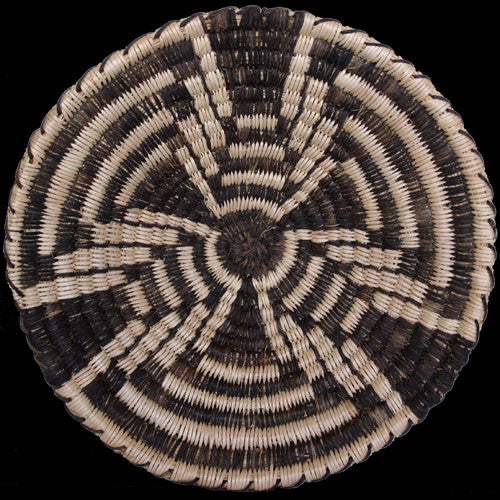
Tohono O'odham 3 Pedal Squash Blossom Willow Basket - Gladys Antone (#01)
$490.00
Artist: Gladys Antone
Native American Basketry
7" x 1" deep
Rounds: 16
We offer a 100% satisfaction guarantee on every purchase.
Related legends:
Navajo Basketry
Basketry is a woman's industry, which is also pursued by the nadle (he changes), hermaphrodites, or men skilled in the arts and industries of both men and women. Basketry, however, is not classified with textile fabrics (yistl'o), but with sewing (nalkhad). It is of interest also that, while the basket is in progress, the sewer is untouched and avoided by the members of her family?
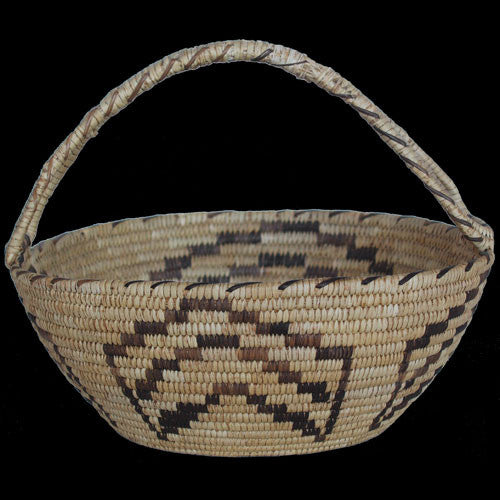
Tohono O'odham Woven Basket w/ Handle (#17)
$375.00
Artist: Tohono O'odham
Native American Basketry
10" across 8 1/2" tall
When this basket was first woven, sometime in the late 1960s or early 70s, the weaver would have been recognized as Papago. The Papago people are, however, now known as the Tohono O'odham. They are a Native American group primarily residing in the Sonoran Desert of southeastern Arizona and northwestern Mexico. Today there is a Tohono O'odham Nation located in southern Arizona. It is unfortunate the weaver has gone undocumented. Whoever he/she was, however, the weaving abilities demonstrated with this basket are highly refined.
We offer a 100% satisfaction guarantee on every purchase.
Related legends:
Wickerwork
The carrying basket is even less frequently seen than the water jar. tsizis (tsi, hair, and zis, or azis, a bag or pouch, from the mode of carrying it over the hair of the forehead) is used at present for gathering the hashkan, or yucca fruit, for syrup. The baskets are plaited of willow twigs much after the style of our own baskets, but have neither handle nor finished rim? More about this legend
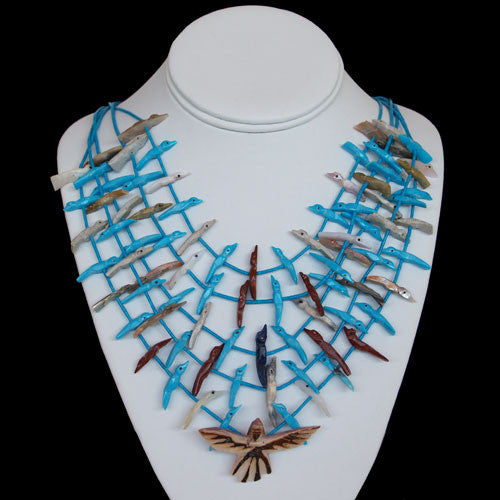
Zuni 5 Strand Fetish Necklace - George Cheechee (#01)
$2,500.00
Artist: George Cheechee
Zuni Jewelry
Smallest Strand: 19"
In his book Zuni Fetishes & Carvings, author Kent McManis references George Haloo CheeChee as one of the most important figures in the Zuni fetish-carving world. George started carving in the 1930s and was best known for his fetish necklaces, which are distinguished by the slightly turned animal heads. Because of his unusual name, George was often referred to by numerous variations of his moniker. With all of George's fetish necklaces, he carved the birds while someone else provided the heshi and strung them into a necklace, which is the case with this piece. George passed-away in 1983, and since then, his fetishes have become extremely collectible.
We offer a 100% satisfaction guarantee on every purchase.
Related legends:
Zuni Fetishes
Navajo fetishes represent a specific area of Navajo art and culture, often misunderstood and sometimes misrepresented. It is assumed by many that Navajo fetishes exist for purely commercial reasons. There is, however, a tradition of fetish use by Navajo people, either as part of personal pollen sacks carried by individuals or as part of a jish, the sacred bundles used by Navajo medicine people.
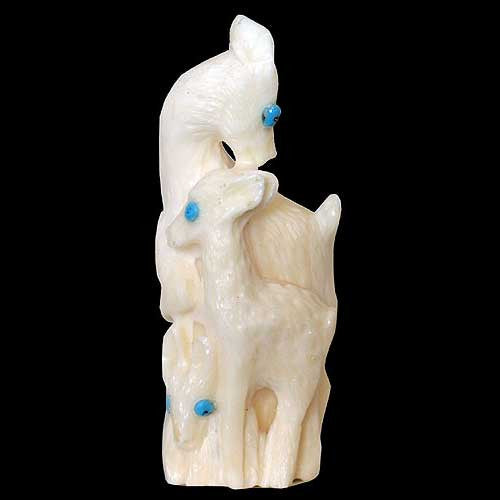
Zuni Antler Deer & Fawns Fetish - Max Laate (#02)
$225.00
Artist: Max Laate
Zuni Fetishes
1 7/8" tall x 3/4" wide
We offer a 100% satisfaction guarantee on every purchase.
Related legends:
Deer
Eating certain parts of deer will cause illness: head; nosebleed and head swelling, heart; bleeding, digestive; turn into a snake. More about this legend
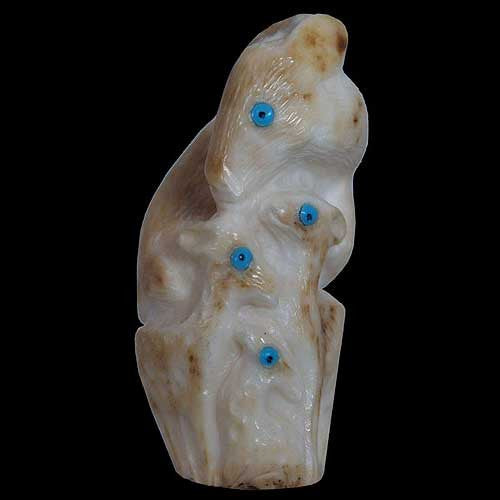
Zuni Antler Deer & Fawns Fetish - Maxx Laate (#03)
$225.00
Artist: Maxx Laate
Zuni Fetishes
Antler Deer & Fawns Fetish
1 3/4" tall x 3/4" wide
We offer a 100% satisfaction guarantee on every purchase.
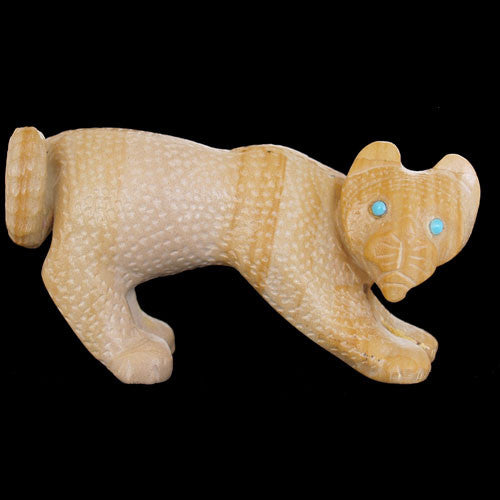
Zuni Brown Serpentine Mountain Lion Fetish - Wilford Cheama (#03)
$250.00
Artist: Wilford Cheama
Zuni Fetish
3/4" x 2 1/2" x 1 1/4" tall
In Zuni culture fetish carvings represent animals spirit, which reside in the stone. The less animate an object, the closer to the spirit world it is. A stone carving of an animal brings its owner in contact with the applicable deity. Wilford Cheama has carved an exceptional representation of a mountain lion, also known as "Elder Brother”. Fashioned of brown serpentine, Wilford's mountain lion displays all the grace and beauty of this magnificent animal. It looks as if the lion is ready to spring into an all-out sprint at any moment.
We offer a 100% satisfaction guarantee on every purchase.
Related legends:
Zuni Fetishes
Navajo fetishes represent a specific area of Navajo art and culture, often misunderstood and sometimes misrepresented. It is assumed by many that Navajo fetishes exist for purely commercial reasons. There is, however, a tradition of fetish use by Navajo people, either as part of personal pollen sacks carried by individuals or as part of a jish, the sacred bundles used by Navajo medicine people.
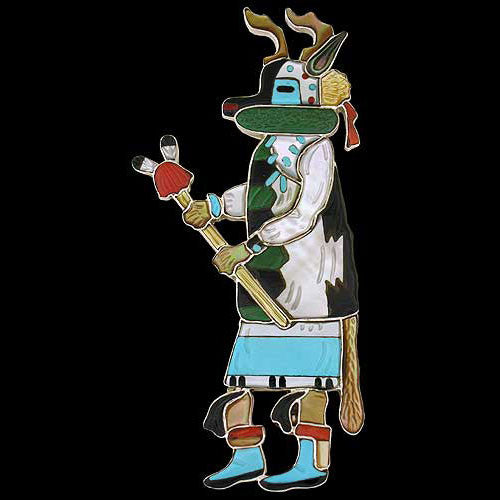
Zuni Deer Kachina Pin/Pendant - Andrea Lonjose Shirley (#04)
$595.00
Artist: Andrea Lonjose Shirley
Zuni Jewelry
Sterling Silver Inlay Zuni Deer Kachina
Pin/Pendant set with Malachite, Jet,
Mother of Pearl, Coral, Turquoise,
Gold Lip and Abalone Shell
3 1/2" tall x 1 5/8" wide
We offer a 100% satisfaction guarantee on every purchase.
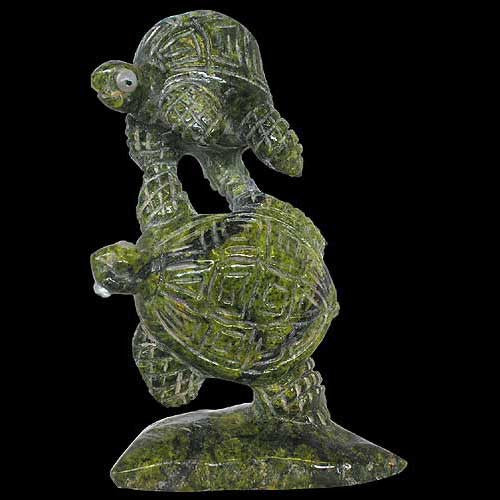
Zuni Double Serpentine Turtle Fetish- Ron Laahty (#04)
$270.00
Artist: Ron Laahty
Zuni Fetish
Double Serpentine Turtle
Fetish Set with Jet and
Mother of Pearl Eyes
2 5/8" tall x 1 5/8" wide
Turtles are water symbols to the Native people of the Colorado Plateau. In this carving, master artist Ricky Laahty has put his skills to work and created a stack of water creatures. Always on the lookout for special stones, Ricky has used a deep green serpentine to craft this marine marvel. Yertle the Turtle King has nothing on this seafaring duo.
We offer a 100% satisfaction guarantee on every purchase.
Related legends:
Turtle & Frog
This episode appears in four versions of the attack on the Pueblo. It precedes the story of the main attack or constitutes this attack. The scalps which they obtain are, however, not the object of the suitor test. Frog and turtle kill the enemy or their young women. They have hidden in the "walled up water supply" which is drawn off to reveal them? More about this legend
Precious Stones
Turquoise; Precious stones have symbolic implications. For example, turquoise if a "collective term for all the precious stones, wealth, or mixed offerings. Good fortune is attributed to this stone." Both white shell and turquoise are emphasized in Kinaalda? More about this legend
Zuni Fetishes
Navajo fetishes represent a specific area of Navajo art and culture, often misunderstood and sometimes misrepresented. It is assumed by many that Navajo fetishes exist for purely commercial reasons. There is, however, a tradition of fetish use by Navajo people, either as part of personal pollen sacks carried by individuals or as part of a jish, the sacred bundles used by Navajo medicine people.
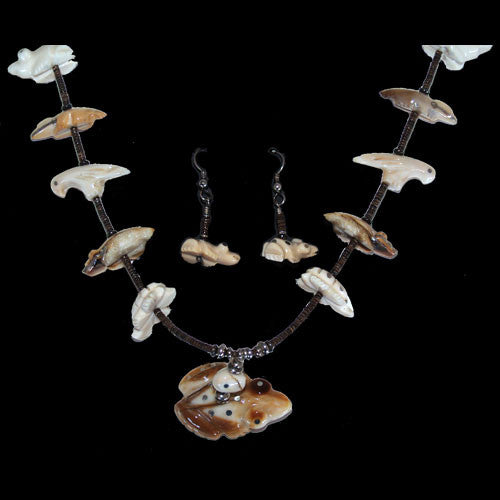
Zuni Fetish Necklace and Earrings Set - Debra Gasper (#01)
$1,350.00
Artist: Debra Gasper
Zuni Jewelry and Fetishes
Necklace: 30" long
Earrings: 1 1/2" long
Using ancient fossil ivory, Zuni fetish carver Debra Gasper has created a monstrously beautiful necklace. Eagles, turtles, eagles and a variety of other animals make this a stunning neckpiece. Throw in the earrings, and this is a terrific addition to your collection.
We offer a 100% satisfaction guarantee on every purchase.
Related legends:
Zuni Fetishes
Navajo fetishes represent a specific area of Navajo art and culture, often misunderstood and sometimes misrepresented. It is assumed by many that Navajo fetishes exist for purely commercial reasons. There is, however, a tradition of fetish use by Navajo people, either as part of personal pollen sacks carried by individuals or as part of a jish, the sacred bundles used by Navajo medicine people.
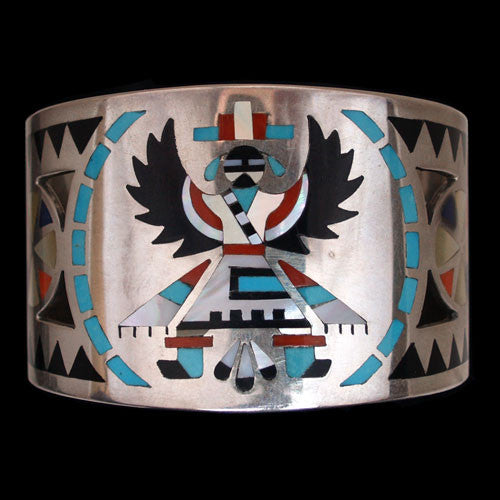
Zuni Knife Wing Cuff Bracelet - Dennis & Nancy Edaakie (#03)
$2,400.00
Artist: Dennis & Nancy Edaakie
Zuni Jewelry
Inner Circumference: 5 1/4"
Opening: 1 1/4"
Total: 6 1/2"
Width: 1 3/4"
Wow! That is likely the best response to this 1970s Zuni Knife Wing bracelet by Dennis and Nancy Edaakie. Dennis and Nancy became famous for their inlay work, and one look at this antique cuff will tell you why; they were expert in their design and stonework. Using turquoise, jet, shell and coral, they created jewelry that became classic. Dennis has gone on to his great reward, so acquiring his artwork has become a treasure hunt.
We offer a 100% satisfaction guarantee on every purchase.
Related legends:
Zuni Fetishes
Navajo fetishes represent a specific area of Navajo art and culture, often misunderstood and sometimes misrepresented. It is assumed by many that Navajo fetishes exist for purely commercial reasons. There is, however, a tradition of fetish use by Navajo people, either as part of personal pollen sacks carried by individuals or as part of a jish, the sacred bundles used by Navajo medicine people.
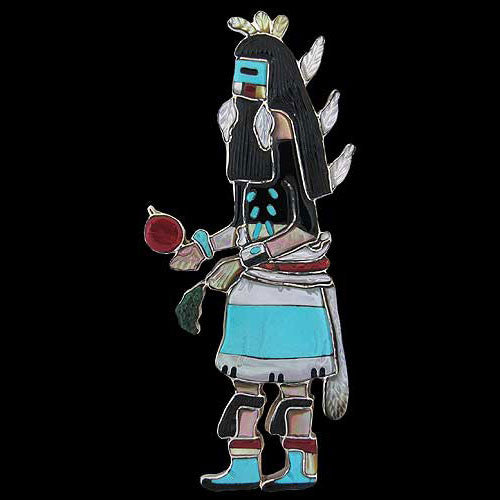
Zuni Male Rain Dancer Pin/Pendant - Andrea Lonjose Shirley (#02)
$595.00
Artist: Andrea Lonjose Shirley
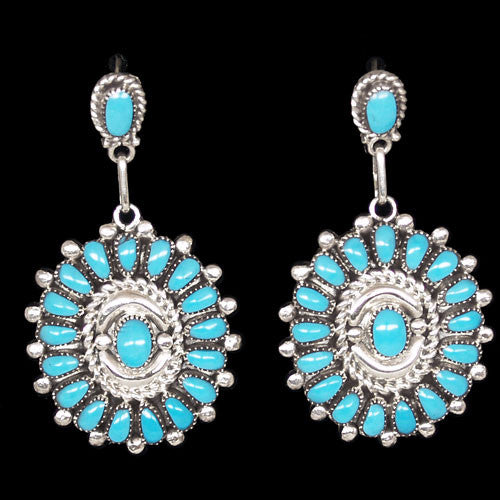
Zuni Natural Sleeping Beauty Turquoise Dangle Earrings - Lorraine Waatsa (#04)
$450.00
Artist: Lorraine Waatsa
Zuni Jewelry
1 1/4" x 2 1/4"
Just when we thought there wasn't any more Sleeping Beauty turquoise left in Zuni, New Mexico; Lorraine Waatsa came up with some. What we appreciate about her discovery is that she shared her treasure with us. Lorraine created this bright and beautiful pair of cluster earrings and we were there to swoop in and grab them up. How fun is that?
We offer a 100% satisfaction guarantee on every purchase.
Sleeping Beauty Turquoise
The Sleeping Beauty turquoise mine is located seven miles from Globe, Arizona. The mine is one of the largest producers of turquoise in North America. The mine, and the turquoise extracted from it, derives its name from Sleeping Beauty Mountain, which at one time was part of the Copper Cities operation. The center of the copper mine is located at approximately 33o24"13.23"N. 110o53'34. 60"W, at an elevation of 1224 feet. Sleeping Beauty Turquoise Mining is presently owned and operated by Monty Nichols.
For many centuries before the first Europeans made their way into Arizona, turquoise was being mined on the slopes of Sleeping Beauty Mountain. The Salado and other ancient peoples mined the beautiful sky stone from several surface outcroppings located in the vicinity, including Pinto Valley. It is believed that Spanish explorers were the first Europeans to locate the source of Sleeping Beauty sometime around the 1860s. By the 1870s, small underground mines pockmarked the hills surrounding present day Globe.
Cities Service Company started the Copper Cities Mine (commonly called the Sleeping Beauty Mine) in 1952 and operated it until the Pinto Valley mine opened in 1972. During the 1960s, L.W. Hardy had the contract to mine turquoise, both at Sleeping Beauty and at Castle Dome, later called the Pinto Valley Mine. Formerly a meat cutter at a market in Miami, Hardy recognized early on that turquoise was more valuable as a gemstone than the associated copper.
By the time the turquoise boom began, Hardy had contracts with mining companies in Miami, Kingman and elsewhere. He also developed a method for stabilizing low-grade, porous turquoise with pressure-impregnated hot acrylic resin, which hardened the stone and improved the color.
Hardy's mining methods were primitive when compared with current operations. Hardy's workers sat in a ditch ripped by a bulldozer and hand picked the stone from waste-rock. Hardy mined turquoise at Sleeping Beauty for 22 years, getting about 45 percent recovery, and leaving the rest in waste dumps.
Monty Nichols received the contract to mine Sleeping Beauty turquoise in 1988, and began using modern mining methods to develop the property. Nichols drills and blasts the overburden, hauling it to the abandoned Copper Cities pit, which now contains the recycled tailings from Miami Copper Company's No. 5 tailing dam. The old dam dominated the eastern skyline of downtown Miami until recently. The year Nichols acquired the contract; he began a two-year project to remove 5,000.000 tons of overburden. Located half way up the side of an open pit mine, the narrow turquoise-bearing zone has about 400 feet of hard waste rock on top of it. In order to move sideways into the ore-body, a whole slice of the mountain had to be removed.
To avoid fracturing the turquoise, Nichols was careful not to blast too near the turquoise-bearing strata. That layer is more crumbly, so the miners can rip it and dump it over screens, separating the material by size. No crushers are used, again to avoid fracturing the gemstone, and the different sized rock is hauled up to a wide mine bench where conveyor belts move the material through three buildings. There, workers handpick turquoise from the broken rock. The buildings are vented with filtered air to eliminate workers' exposure to dust, and well insulated to keep them comfortable in any weather. It is a far cry from the old methods of mining. Anywhere from 30 to 40 people work at the mine at any one time, depending on how much mining there is to do.
Fifty years ago, mine workers filled lunch buckets with the colorful rock, even though it was reason for immediate termination. Old habits die hard, and some people still think it is okay to sneak in and try to pick turquoise. As a result, security is tight in and around the mine. Motion detectors, night vision cameras and 24/7 roving patrols are used, so the only turquoise leaving the property now is being shipped to markets around the world.
Italy is the largest volume buyer of Sleeping Beauty turquoise, with Germany and Hong Kong following closely behind. These customers buy the best grade for their exclusive jewelry. Jewelry makers in India and Spain also receive Sleeping Beauty turquoise, while in the U.S., Gallup and Albuquerque are the largest consumers.
The Sleeping Beauty turquoise mine produces a uniform light to medium blue turquoise with rare finds of deep, dark blue. Because of its uniformity, it has been a favorite of the Zuni Pueblo. Zuni silversmiths often use it in channel inlay and various types of cluster work that require large numbers of small, perfectly matched stones. The Sleeping Beauty mine has been one of the larger producers of rough turquoise in the United States, although today much less good turquoise is being produced than in the past.
Sleeping Beauty turquoise is noted for its solid, light blue color with no matrix; the host rock is usually granite. Nichols says the mine is producing about 1,600 pounds a month. Of that, only four percent is natural; most of the turquoise from the mine is altered in some way. Most is enhanced, which is more expensive than stabilization, and sold to large distributors in this country and Europe. Currently most of the turquoise that comes from the mine is from the tons of tailings piles that have been accumulating for decades.
The best of the Sleeping Beauty turquoise is comparable to that found in the Middle East. It is thought that large quantities of Sleeping Beauty turquoise is taken overseas and smuggled into, then out of, Iran to be sold as “Persian” turquoise.
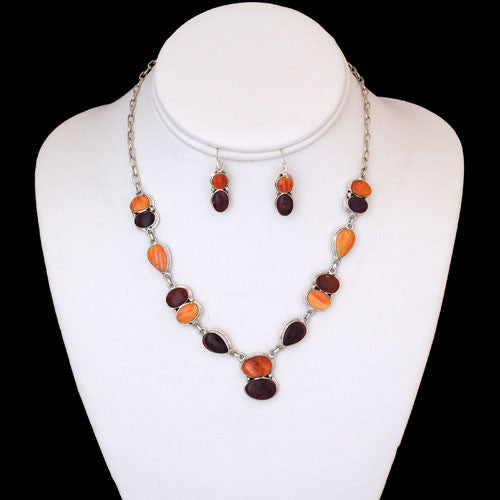
Zuni Spiny Oyster Shell Earrings and Necklace Set - Jillian Etsaty (#42)
$448.00
Artist: Jillian Etsaty
Zuni Jewelry
Necklace: 18"
Earrings: 1 1/4"
Jillian Etsaty from Zuni Pueblo has put together orange and purple spiny oyster shell to create a sweet little necklace and earring set that will please the woman in your life (or you of you are the woman in your life).
We offer a 100% satisfaction guarantee on every purchase.
Peter & Phansy Natachu
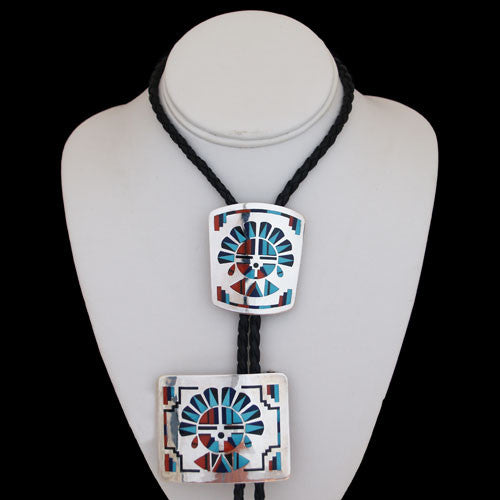
Zuni Sterling Silver Inlayed Bolo and Buckle Set - Peter & Phansy Natachu (#01)
$1,750.00

Zuni Sterling Silver Inlayed Bolo and Buckle Set - Peter & Phansy Natachu (#01)
$1,750.00
Artist: Peter & Phansy Natachu
Bolo: 1 3/4" x 2 1/8"
Strap: 40"
Buckle: 2 1/2" x 2"
This Zuni inlay buckle and bolo tie set by Peter and Phansy Natachu is fine indeed. Using Sleeping Beauty turquoise, Mediterranean coral and Utah jet, Peter and Pansy have recreated the sun god in grand style. Clean and precise, this is Zuni work as it should be.
Related legends:
Zuni Fetishes
Navajo fetishes represent a specific area of Navajo art and culture, often misunderstood and sometimes misrepresented. It is assumed by many that Navajo fetishes exist for purely commercial reasons. There is, however, a tradition of fetish use by Navajo people, either as part of personal pollen sacks carried by individuals or as part of a jish, the sacred bundles used by Navajo medicine people.
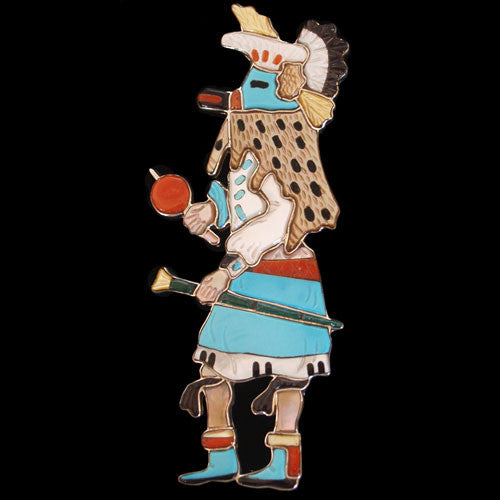
Zuni Sterling Silver Multi-colored Sky Gemstone Kachina Dancer Pin/Pendant - Andrea Lonjose Shirley (#01)
$595.00
Artist: Andrea Lonjose Shirley
Zuni artist Andrea Lonjose Shirley makes gorgeous pieces of handmade art. Legendary Zuni artist Shirley Benn taught her, her crafting ability. This pin/pendant is inspired by Andrea's Zuni culture. This piece demonstrates her incredible talent with free form silver work and multi-stone inlay; nobody does it better.
Related legends:
Zuni Fetishes
Navajo fetishes represent a specific area of Navajo art and culture, often misunderstood and sometimes misrepresented. It is assumed by many that Navajo fetishes exist for purely commercial reasons. There is, however, a tradition of fetish use by Navajo people, either as part of personal pollen sacks carried by individuals or as part of a jish, the sacred bundles used by Navajo medicine people.
